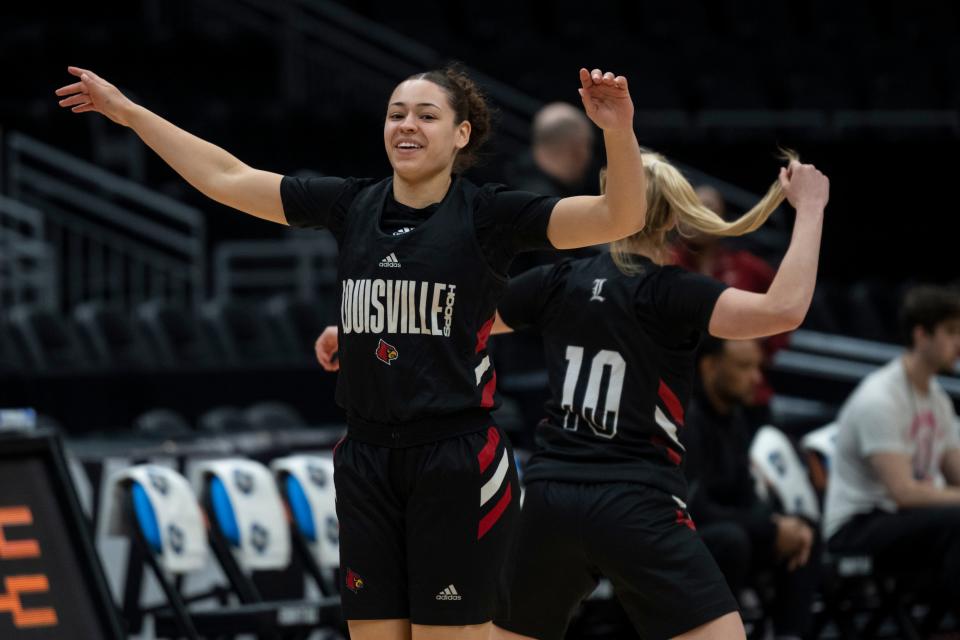Why does NCAA women's tournament have just two regional sites for Sweet 16, Elite Eight?
Look at the bracket for the NCAA women’s tournament games this weekend and instead of “Las Vegas” or “East,” you’ll see Greenville 1 and Seattle 4.
Is this March Madness or an AAU tournament?
Well, it’s a little bit of both.
In the interest of trying to generate more attention for the women’s tournament from fans, media and potential hosts, the NCAA switched up its traditional format. Rather than spreading eight games over four geographical regions, there will be two “super regionals” with four games each.
“I think it's great. It adds a lot of excitement to it,” Miami coach Katie Meier said Thursday. “It's just fun just even walking the hallways and seeing all the logos and seeing how many teams are here together. I think it's going to be great for women's basketball, so I'm excited about that.”

Women's NCAA Tournament: Watchability rankings for Sweet 16 games
Sign up for our sports newsletter: Keep up with March Madness with our daily sports newsletter, delivered right to you!
How did this start?
The NCAA and powerbrokers in the women's game have been discussing ways to generate more interest in, and revenue from, the women's tournament for the better part of a decade. Even as attendance at the women’s tournament has grown, and the Final Four has sold out, turnout at the regionals has varied.
In 2018, the regional site in Albany, New York, drew 10,658 fans – the UConn effect – while the one in Kansas City had 4,280. The numbers were far more positive last year, with each of the four sites drawing 7,100 fans or more.
But the NCAA had already decided in 2020 to try the super regional idea starting this year.
“It’s kind of like mini-Final Fours,” Lisa Peterson, chair of the Division I women’s basketball committee, told The Washington Post. “You will know that there is a big women’s basketball tournament that’s happening there.”
How it works
Two cities are chosen as regional hosts, and there will be four games at each site.
Unlike the traditional format, where a site has two games followed by an off day, there’s basketball every day for four days. The semifinals of one region are Friday followed by the semifinals of the other region Saturday, with the regional finals played Sunday and Monday.
For fans visiting from out of town, it means there’s always something to watch. No scouring the Internet for “must see” activities in “fill in the blank” city to kill time on the off day.
Boosting interest
The NCAA hopes having 15,000-plus basketball fans staying in hotels and eating in restaurants for three or four days will entice more cities to bid for the super regionals. It also hopes the idea of being able to see more basketball will appeal to fans who might not otherwise have gone to a regional site.
It should eliminate some of the guesswork for fans trying to figure out where their team is going to be playing. The NCAA will try to send the top seeds to the super regional closest to their campus – though close is a relative term this year.
Of the eight teams in the Seattle region, Colorado is the closest – and it’s 1,300 miles away.
“Obviously we're a long ways from Iowa City,” Iowa coach Lisa Bluder said. “I really believe that if this site would have been five hours from Iowa City, we would have 10,000 Hawkeye fans here. And it's just unfortunate that our fans won't be able to support us live.
“But at the same time, we're glad we are here. We think Seattle's going to be a great host site. The city seems really nice, our hotel's great, everything's been wonderful. But, yeah, I wish it was closer to home.”
A permanent change?
Though super regional sites have been announced through the 2026 tournament, the NCAA has not committed to making this a permanent change. If it doesn’t generate higher attendance and greater interest, the NCAA could scrap the format and revisit some of the other ideas it’s had. Like pairing regionals of the men’s and women’s tournament.
For now, though, the NCAA is optimistic about the change.
Those actually playing in the tournament are reserving judgment.
“I don't know what that's going to look like I guess is my answer,” Texas coach Vic Schaefer said before the tournament began. “I'm anxious to see. Probably a little concerned. But I'm anxious to see what it looks like. And I think the powers that be believe it's going to be great, and I'm hopeful that it will be.”
This article originally appeared on USA TODAY: Women's NCAA Tournament 'super regional' format, explained

 Yahoo Movies
Yahoo Movies 
